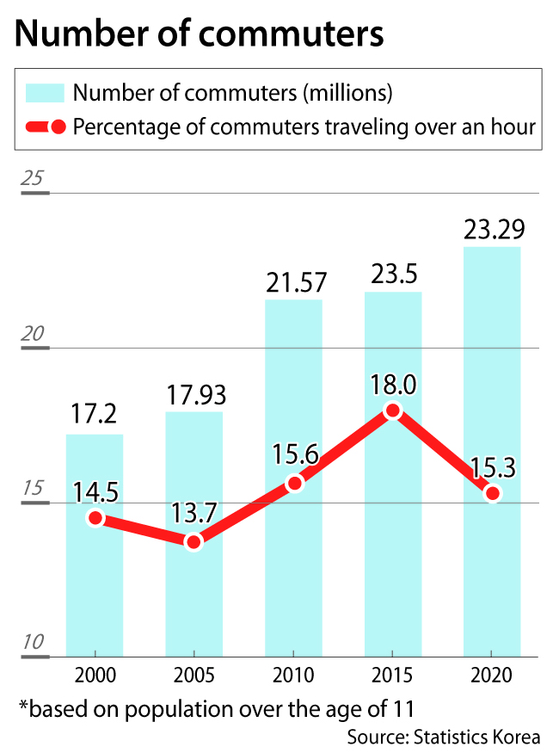Government policies still fail to resolve long commutes
Published: 27 Aug. 2023, 17:34
Updated: 28 Aug. 2023, 11:49
-

- CHO JUNG-WOO
- cho.jungwoo1@joongang.co.kr
![Passengers squeeze into a subway car at Gochon Station on Gimpo Gold Line on April 18. [YONHAP]](https://koreajoongangdaily.joins.com/data/photo/2023/08/28/1a48c5c0-4669-4a66-8ef3-05b97db46fda.jpg)
Passengers squeeze into a subway car at Gochon Station on Gimpo Gold Line on April 18. [YONHAP]
Commuters in Korea continue suffering from long commute times and distances despite governmental efforts to resolve the issue.
“Commuting on the so-called hell trains is a matter of survival,” according to a 39-year-old office worker who takes the Gimpo Gold Line, Airport Railroad Express and subway line No. 1 from her home in Gimpo, Gyeonggi, to her office in Yongsan District, central Seoul.
She was able to get rid of the commuting stress last year during her annual leave but said she is afraid of the nightmare that will begin as soon as she returns to work.
“This torment is not something one person can solve,” she said.
“This social issue requires government intervention.”
The country has been mulling measures to relieve congestion during rush hours and inconvenient commutes since the population became heavily concentrated in the greater Seoul area.
The government initially focused on supplying housing in office-dense cities and their neighborhoods.
In the 1970s and 80s, the country developed new towns near Jamsil in southern Seoul and large house complexes in Gaepo-dong, southern Seoul, Godeok-dong, eastern Seoul, Mok-dong, western Seoul and Sanggyeo-dong in northern Seoul.
In 1989, a year after the population in Seoul exceeded 10 million, the government supplied some two million houses in five new cities in Gyeonggi, including Bundang in Seongnam, Pyeongchon in Anyang and Ilsan in Goyang.
Building new cities became the main solution for commuting issues, but only increased the distance and time.
Some of the new cities the government announced for development in 2003 were as far as 30 kilometers (19 miles) from Seoul.
Transportation access to these cities was poor, excluding some areas such as Pangyo in Seongnam and Gwanggyo in Suwon.
To resolve the long commute distance and time for office workers, the government began rolling out plans to improve the country’s transportation network.
A basic plan to improve transportation systems and roads in large cities was announced in 2007.
In 2019, the Ministry of Land, Infrastructure and Transport founded the Metropolitan Transport Commission to “alleviate traffic congestion in metropolitan and enhance convenience of transport.”
The country’s goal at the time was to reduce the commute between cities to a mere 30 minutes as well as cut costs and transfer time by 30 percent.
“We acknowledge the stressful commute has become a critical issue in society,” a spokesperson for the Metropolitan Transport Commission said.
“The organization is pushing measures such as building infrastructure for transportation between multiple cities and increasing the number of buses that travel multiple cities.”
Experts point out that the policies announced and implemented within the past 30 years have failed as an “essential resolution” for the issue.
“Expanding the transportation network only increases the time and distance required to travel to Seoul for work,” according to Lee Yun-suk, an urban science professor at the University of Seoul.
“The expansion of the transportation network leads to the expansion of the metropolitan area, meaning that the average time that office workers waste during their commute is not significantly reduced.”

The figure has been on the rise except for during Covid-19.
“With most of the macro policies failing, the government needs to think of alternatives that would help those who relatively suffer more from long commute hours.”
Flexible work arrangements are another way the government is trying to implement to resolve inconvenient commute issues.
During the Covid-19 pandemic, in particular, many office workers worked from home. According to a report released by the Bank of Korea last year, 1.14 million people worked remotely, a twelve-fold increase from 2019’s 95,000.
“A study shows that [working from home] will increase productivity by 4.6 percent as reducing commute hours and enhancing flexibility increases employees’ satisfaction level at work and companies can cut costs in maintaining offices.”
The Ministry of Employment and Labor announced a comprehensive manual in 2020 with procedures for implementing remote work, personnel and organizational management strategies and government support systems.
Some politicians are also actively supporting the measure. In August last year, Democratic Party lawmaker Park Seong-joon proposed an amendment to the Labor Standards Act that included provisions allowing remote work for up to 8 hours weekly.
The existing law lacked a solid basis for workplace flexibility, often leaving companies to decide on implementing flexible work arrangements according to their regulations.
Changes are also becoming evident in the job market.
![Je Yeon-joo, 29, an office worker at an e-commerce company, works from home. [JE YEON-JOO]](https://koreajoongangdaily.joins.com/data/photo/2023/08/28/e3da01fb-bdd8-417c-a776-27cf435df722.jpg)
Je Yeon-joo, 29, an office worker at an e-commerce company, works from home. [JE YEON-JOO]
Je Yeon-joo, 29, working at an e-commerce company, said that she prioritized the option to work remotely during her two job transitions.
Je had to suffer from a "hellish commute" every morning, traveling over an hour and a half from her home in Guri, Gyeonggi to her office in Gangnam District, southern Seoul, and then back home after a long day at work.
She often skipped breakfast and dinner due to the exhausting commutes but now has the time to cook after starting to work remotely with her new job.
"After experiencing remote work during the Covid-19 pandemic, I now avoid companies without flexible work arrangements when applying for new jobs," Lee Yoo-mi, 34, working at a startup in Gangnam, said.
"Many people around me share similar standards [when switching jobs]."
However, some argue that flexible work arrangements could even decrease work efficiency rather than address commuting issues.
"I find it difficult to learn new tasks and collaborate because I go to the office three to four times a month and communicate online,” said a 32-year-old who commutes to an IT company in Pangyo, Gyeonggi.
Some industries and smaller companies are either less willing to shift to such work arrangements or incapable of implementing them.
“[The government failed to] reduce commuting time despite launching various initiatives, such as building new towns and expanding transportation networks," Jang Jae-min, director of the Korea Urban Policy Institute, said.
"Commuting policies should focus on alleviating the over-concentration in the metropolitan area rather than working towards the elusive goal to have workplaces close to home."
BY HAN YOUNG-IK,YUN JUNG-MIN,SHIM SEOK-YONG,KIM HONG-BEOM,KIM MIN-JUNG,CHOI SEO-IN AND CHO JUNG-WOO [cho.jungwoo1@joongang.co.kr]










with the Korea JoongAng Daily
To write comments, please log in to one of the accounts.
Standards Board Policy (0/250자)